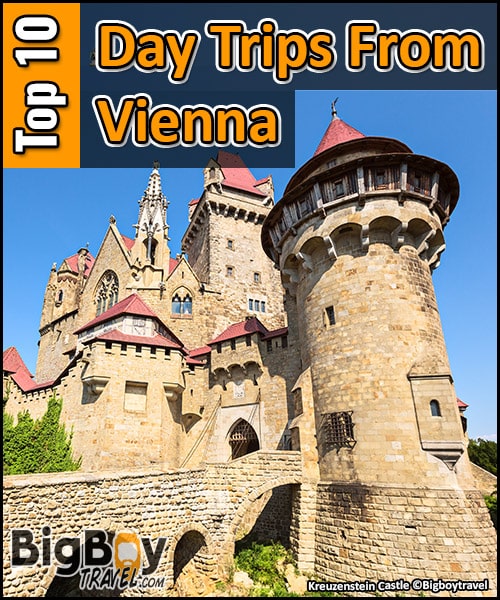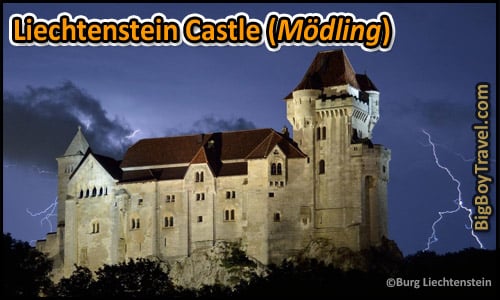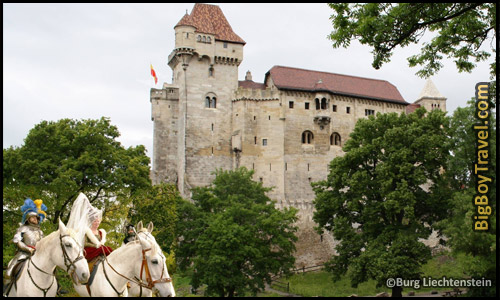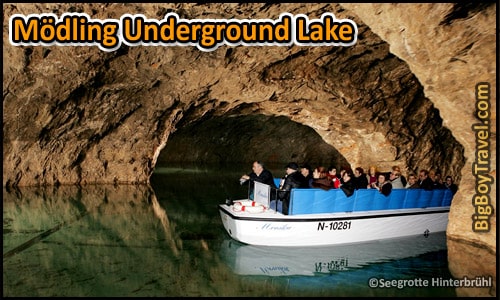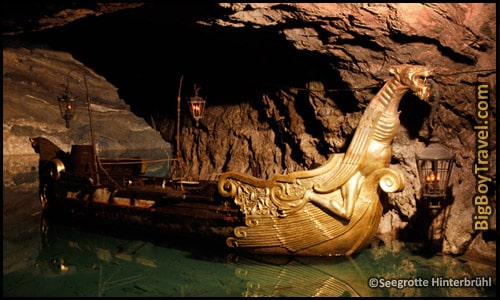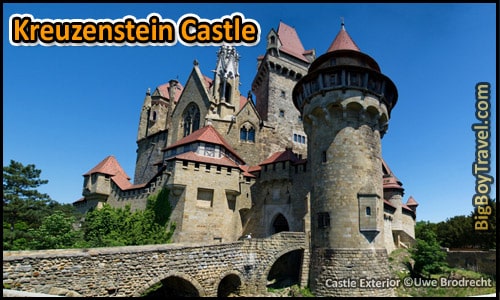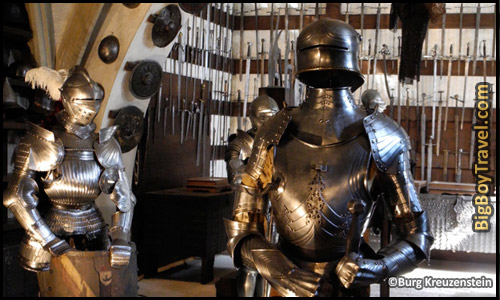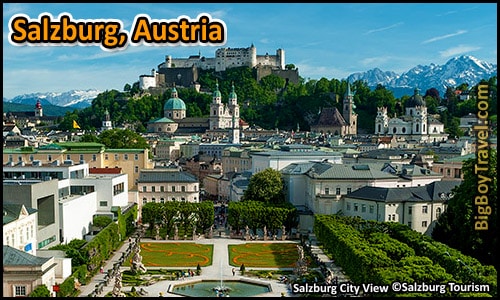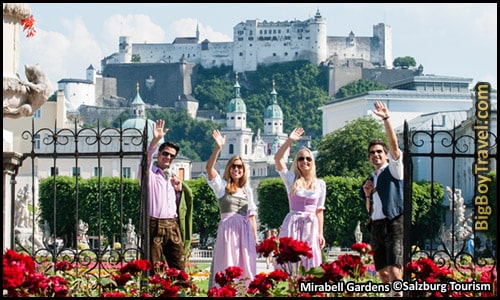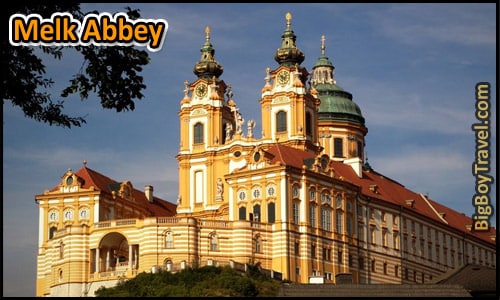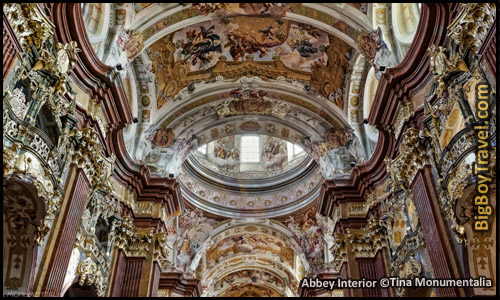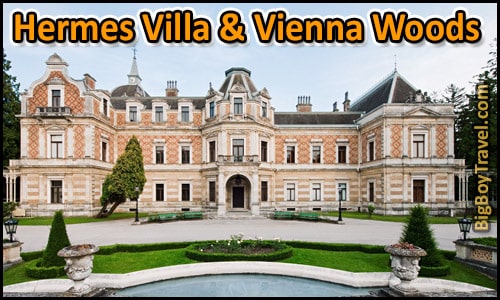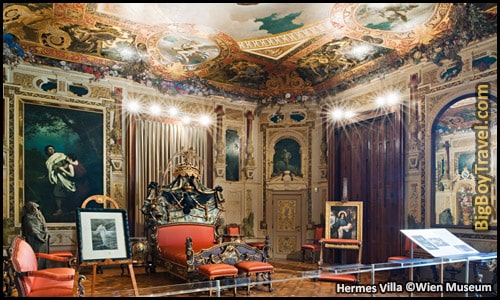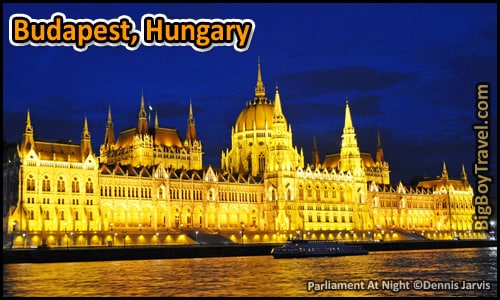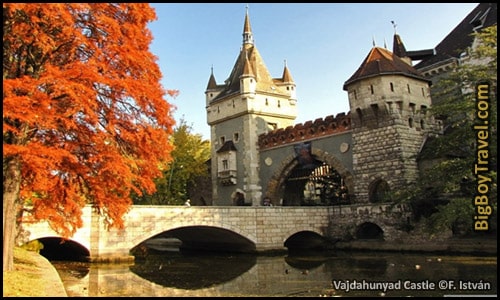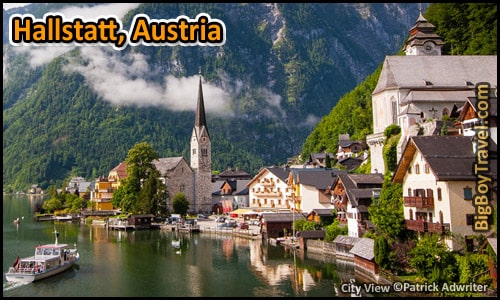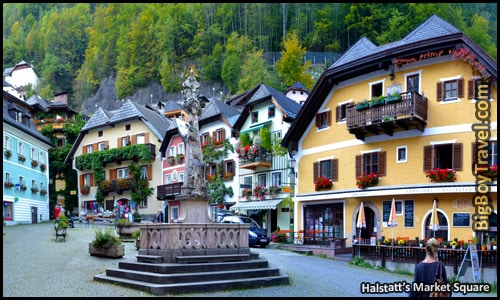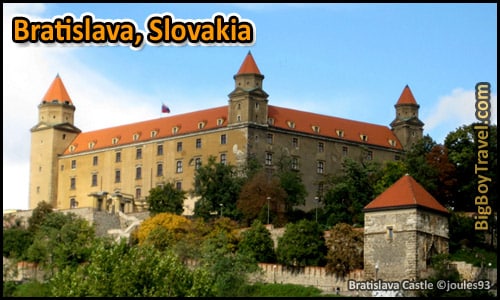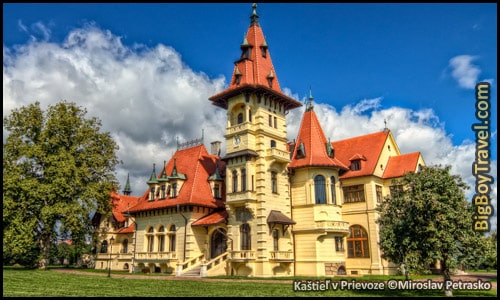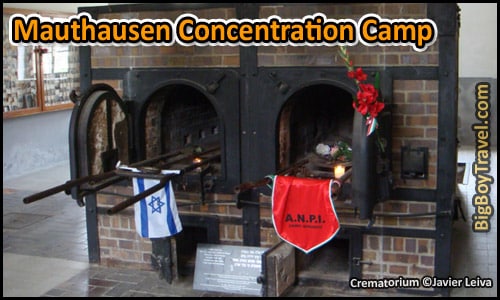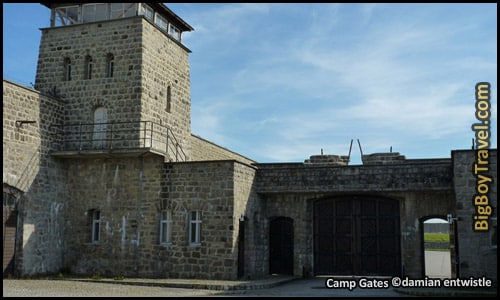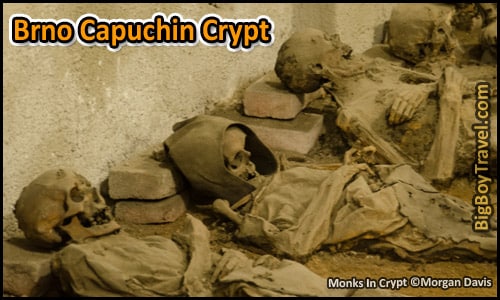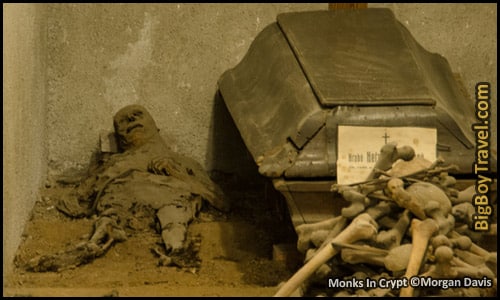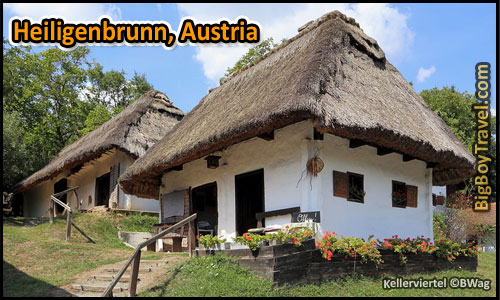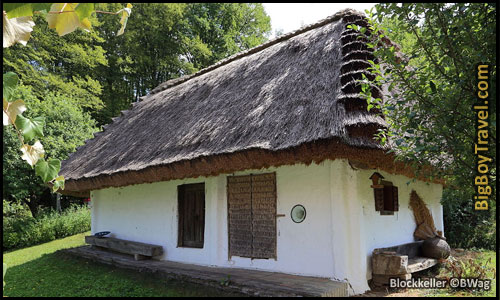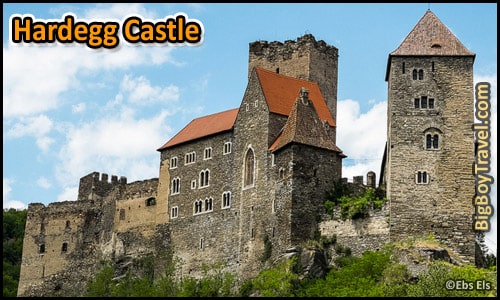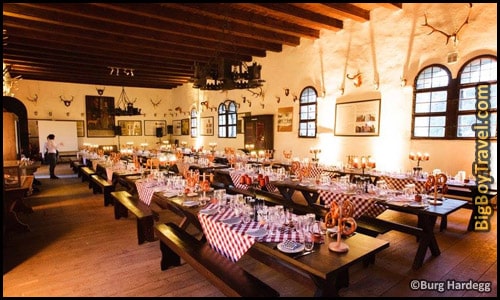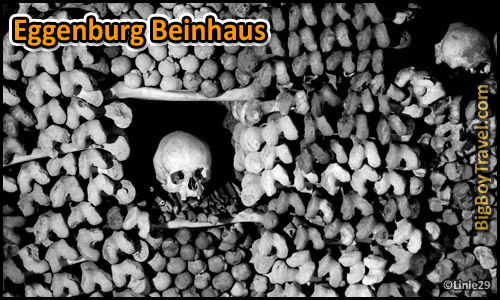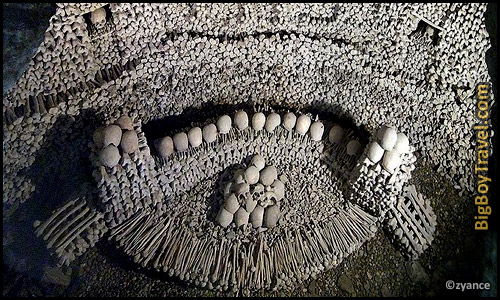Top Day Trips From Vienna:
If you find yourself looking for something to do outside on Vienna it can be a little daunting, but we’re here to help. We have come up with a great list of the best day trips to take from Vienna and more importantly how you actually get to each place. You can easily see any of these and still get back to Vienna the same day or choose to fit these in as a side trip on the way to your next destination. Enjoy our list of the top day trips from Vienna Austria!
Train Tickets & Transportation Info:
These top day trips from Vienna are very easy to do by yourself with the convenient Austrian train system. To help with planning your transportation, the National Austrian Railway Website (website) has all of the regional Train/Bus routed, timetable information, and online tickets. For short day trips the full fare will only be around 5€ round-trip a person, for medium length trips like Melk it is around 34€ round-trip per adult, and for longer trips the price goes up to around 80€ round-trip per adult to Budapest or 110€ for Salzburg.
If you are able to book any medium to longer day trips in advance they-they have special Sparschiene fares that can be discounted up to 80% off the full fare. The special Sparschiene fares can be booked starting 6 months in advance on the National Train website, but because there is a limited number sold per train, you will typically need to buy them at least 30-45 days or sooner ahead your journey before they are sold out. If you need more advanced schedule options or want to force the route to only looking for buses or certain types of trains you need to use the rail company’s advanced booking engine (website).
Day Trips From Vienna:
1. Liechtenstein Castle (Mödling, Austria – 20 Mins Away):
About Liechtenstein Castle: Liechtenstein (light-in-stone) Castle was built in 1130 and stands tall in Medieval glory just a short day trip from Vienna in the Austrian countryside. If you’ve seen the hit 1993 movie The Three Musketeers, then you’ve seen the historic Burg Liechtenstein which was predominately featured in the film.
The castle was owned early on by the famous Liechtenstein family before changing hands and expanding several times over hundreds of years. It’s actually amazing that the castle is standing at all as it was sacked by the Ottomans (Turks) in both 1529 and 1683 before partially sitting in ruin. The current ticket desk actually sits inside a tower ruined by the Ottomans. When the Liechtenstein family regained control of the property in 1807, it was restored and expanded as part of the Historicism (Romanticism) movement to serve as a museum showing off idealized Medieval architecture. Surviving further plunder in WW2, today the castle is available for tours and is one of the only privately owned castles in Austria.
We especially love the approach leading up to Burg Liechtenstein as the mighty castle slowly rises above the trees the closer you get to it. The backdrop is stunning, but there is also a lot to see inside the castle tour during your day trip from Vienna. The chapel (still active) is maybe the most fascinating space in the castle as it is original to 1130 and still has elements of red wall paintings from the 1200s including one of the crucifixion of Jesus. It also houses a relic claimed to be a thorn of Jesus’s crown of thorns from Sainte-Chapelle in Paris.
You’ll find many other elements from the original Romanesque castle structure including a toilet, fireplace, and cistern during your tour of Burg Liechtenstein. Some of the rooms also have interesting statues from the 1300s, the Squire Hall (Knappensaal) has interesting architectural details, the bedrooms have princess balconies overlooking the valley, and the small treasury is nice with a hand-made replica of the Liechtenstein royal crown. Our favorite room though is the Knights’ Hall (Rittersaal) which was created during the more modern Historicism era and looks like it is straight out of a movie set. A hidden gem in the Knights’ Hall is a stone sleeping alcove in the wall that dates back to the 1100s and is one of the oldest beds in Austria.
Getting Here: From Vienna take the Underground Metro to Vienna’s Meidling Train Station on the Southside of town and take a local train to Mödling. Trains leave the station about 10 times an hour and the ride is only 15 minutes south of Vienna. At the Mödling Train Station, you take Bus 262 right to the entrance (Siedlungsstraße stop) which is a 6-minute walk to the Castle. We have also had success using Uber between Mödling Station and the castle.
Visiting Hours: You can see the outside of the castle and take photos any time of day, but you can only go inside as part of a group tour which has been run since the 1800-s. Guided Tour Hours: 50 Minute guided tours at the top of every hour. January & February Saturday at 11am; March-October Daily 10am-4pm (extended to 5pm July & August); November Daily 11am-2pm; December Weekends Noon-2pm. They also take advanced bookings year-round for additional tour times/days. The Treasury tour is every Saturday at 12:30pm. Tour Cost: 9€ for Adults; 6€ for kids; Families 25€. Advanced Booking: To book in advance email them here ursula.krompass@burgliechtenstein.eu. Special Tours: The Castle has a ton of private tour options ranging from 12-20€ and they are really cool. They typically require that you pay for 5+ people but have tours that take you to the top of the tower for wine tastings, cool night tours, and much more. Facebook Page: (HERE). Castle Website: (HERE).
2. Seegrotte Hinterbrühl (Mödling, Austria – 20 Mins Away):
About Seegrotte Hinterbrühl: While in the area you might as well take a boat ride on Europe’s largest underground lake, Seegrotte Hinterbrühl. Starting in the late 1800’s Seegrotte was actually a large thriving gypsum mine which had grown into several levels with dozens of rooms. One of our favorite rooms is the large Festival Ballroom in the upper chamber where all of the miners would gather every December 4th to celebrate the mine’s anniversary and their good luck. That luck ran on during an unfortunate blasting operation in 1912 which let over 5 million gallons of water in, flooding most of the mine.
The water had come from 7 underground springs with no natural drain and basically ended all future mining at Hinterbrühl. It wasn’t until WW2 that anyone starting pumping water out of the mine and it was totally drained by the Nazi’s. With the secrecy of the newly created cave, the manufacturing of the airplanes (Jetfighter “Heinkel HE 162”) was done by 2000 concentration camp prisoners under control of Nazi engineers. Shortly after the Nazis lost WW2 the mine was opened as a tourist attraction with tours.
Because the underground springs had no drainage, the mine became to fill up again re-creating the lake on the mine’s lower level. The caretakers were prepared and have been pumping out excess water daily to keep the water level even. In some places, in the lower chamber the water gets up to over 30 feet deep, but most of the upper level is kept completely dry. Today over 250,000 people a year visit Seegrotte Hinterbrühl getting not only tours of the old mining and plane manufacturing operations but also boat rides on the crystal clear underground lake itself. A visit really is a unique experience and it is no wonder that the lake old mine has been featured in numerous films including the hit movie The Three Musketeers in 1993.
Getting Here From Lichtenstein Castle: Hinterbrühl is only a 1km (10 minutes) walk from the entrance to Lichtenstein Castle making the two places easy to visit together. There are a couple authentic restaurants between the two places if you want to grab a bite to eat. Getting Here From Vienna: From Vienna take the Underground Metro to Vienna’s Meidling Train Station on the Southside of town and take a local train right to Mödling. Trains leave about 10 times an hour and the ride is only 15 minutes south of Vienna. At the Mödling Train Station, you take either Bus 364 or 365 right to the entrance.
Hours: April-October daily 9am-5pm; November-May Weekdays 9am-3pm plus Weekends 9am-330pm. Guided Tours: Cost 10€; leaves every 20 minutes; lasts 45 minutes; Tour includes: the cavernous lake, rooms that the miners used as a chapel, wine cellar, and common room. Lake Website: (HERE).
3. Kreuzenstein Castle (27 to 60 Mins Away):
About Kreuzenstein Castle: With powerful towers, a huge drawbridge, and an impressive collection of Medieval armor, Kreuzenstein Castle is an amazing day trip from Vienna. There has been a hilltop fort at the site of today’s fortress since long before modern Vienna was founded. By the 1100s the fort had grown into the large Castle Grizanstein with views of the Danube River. On a clear day, views across the Danube let you see the towers of Castle Greifenstein, Klosterneuburg Monastery from 1136, as well as Leopoldsberg which was the site of a Celtic fort dating back to 400 BC.
The famous Habsburg Royal Family owned Kreuzenstein Castle for 250 years prior to it being overrun in 1645 by the Swiss Army during the 30 Years War. The Polish Noble family Wilczek took control of the castle ruins in 1702 but it took 172 years for the family to start rebuilding it. The family was extremely wealthy thanks to its Silesian coal mines in Prussia. With an endless budget, Count Johann Wilczek rebuilt the fortress to serve as the family vault and renamed it Kreuzenstein Castle.
In addition to his family fortune, Johann had a lot of influence as an explorer and as the Chamberlain at the court of Emperor Franz Joseph I which gave him even more resources. The Count had huge portions of Medieval buildings from other properties they family owned moved to the Castle which kept the new complex very authentic to Medieval times. The huge castle complex grew to hold a priceless library, amazing works of art, and with more than 100,000 objects. It also gained Austria’s largest private collection of weapons.
A fire in 1915 and shelling during WW2 has damaged some of the artifacts over time, but much of it is still well preserved. In 2012 the castle was featured in the TV series World Without End which was the sequel to hit series Pillars of the Earth. With an amazing wall, courtyards, moat, secret tunnels, and a powerful central castle with a drawbridge, Kreuzenstein Castle sure is a treat to visit.
Getting To The Castle From Vienna: From the Wien Floridsdorf Train Station it is a quick 20-28 minutes to Leobendorf-Burg Kreuzenstein Station (5€ round-trip), but then requires a 35-minute walk over to the castle which is well marked. It is only 27 minutes from Vienna by car to the castle parking lot.
Visiting Hours: Daily April-October 10am-4pm; Sundays until 5pm; Closed November-March. 45 Minute guided tours at the top of every hour. Cost: Adults 10€; Kids 5€. Castle Website: (HERE).
Rating as a Day Trip From Vienna: 10 out of 10. If it was open year round it would easily be our top side trip from Vienna.
4. Salzburg, Austria (2 Hours & 20 Minutes Away):
About Salzburg: Salzburg is the home of Mozart, the beautiful Mirabell Gardens & Palace, and the location for The Sound of Music. Located in the heart of the Alps, Salzburg is a great spot for a day trip just a few miles from Berchtesgaden. While it does make a great day trip, we recommend 2-3 full days in Salzburg to be able to see the old town sites, Sound of Music Sites, and surrounding towns of Hallstatt & Werfen. The top things to do in Salzburg are the Old Town Walking Tour, Schonbrunn Palace, and the Sound of Music Movie Locations Tour which cover dozens of must-see attractions around this timeless city.
Getting To Salzburg From Vienna: It is a very easy and direct 2 hour and 22 minute train ride to Salzburg making it a doable day trip from Vienna. Trains leave every 25-30 minutes starting at 5:30am meaning you can leave early, nap on the train, and get to Salzburg by 8am. There is a lot of flexibility at the last train back to Vienna leaves at 10pm. Tickets are only 24€ each way if you buy more than a week in advance (2-4 weeks is better) or it’s 54€ each way on short notice.
Rating as a Side Trip From Vienna: 9 out of 10. If you are able to spend 2-3 days in Salzburg you will love it even more.
View Our Salzburg Section: (HERE).
5. Danube River Cruise To Wachau Valley:
About The Wachau Valley: The Wachau Valley is one of the most scenic areas to travel as a day trip from Vienna. The banks of the mighty Danube River are littered with castles, small charming villages, and some of the best vineyards in Austria. While many visitors (especially retired ones) visit the area for the famous fortified Melk Abbey, we feel that it is a little overrated by itself unless you do a Danube River cruise to see the rest of the Wachau Valley with it.
6. Melk Abbey (Melk, Austria – 50 Mins Away):
About Melk Abbey: Perched on a bluff above the Danube River, the fortified Melk Abbey is one of the true gems of Austria. Not only is the Abbey one of the best Baroque buildings in Austria, but knowing the history gives you better insight into the founding of Vienna, making it an excellent side trip. The village along with the Melk Abbey can be seen as a standalone day trip from Vienna but is even more enjoyable as part of a Danube River cruise, especially along the Wachau Valley.
The history of the abbey started when Bavaria pushed their territory East against the Hungarians (Magyar) and this bluff became the home to the first Margrave of Austria, Leopold I (House Babenberg), who built his castle here in 976. Leopold I’s noble family line expanded the Babenberger Castle in Melk and filled it with valuable treasures and relics. After 100 years, the Babenberger started moving their family further East (eventually to Vienna in 1146) and gave their castle to the Benedictine monks who have continually been living and working in Melk Abbey (former castle) since 1089.
Because the Babenbergers became the first Dukes of Austria (1146-1246), Melk Abbey was allowed to thrive. Although it did suffer from a fire in 1297, the Abbey became an important place under Papal decree during the Council of Constance of 1414. Building onto the former castle over the centuries, much of the amazing Baroque-style monastery you see today was completed from 1702-1736. The towering red-roofed yellow monastery is quite intimidating as you approach it from the village of Melk. The yellow paint like Schönbrunn Palace in Vienna is iconic of the Hapsburg family who ruled Austria from 1278-1918.
The inside of the Abbey is just as impressive as the outside with its marble floors, golden accents, and lavishly painted ceilings. The marble spiral staircase, gothic church, mummified displays, and grand halls are very impressive. The Hapsburg Emperors loved to visit the Abbey and today a lavish museum is located inside their former private rooms on the property. From the balconies at the Abbey, you will get a great view of the gardens plus the Danube River and surrounding countryside.
Our favorite room is the frescoed library packed with over 100,000 and looks like it is from Beauty and the Beast. In 1997 fragments of the medieval hero epic from the 13th Century called the Nibelungen Saga (“kneeble-lew-gen zaga“) were discovered in the library. Other texts and manuscripts kept here date back to the 9th Century. The famous library was also the impression for Umberto Eco’s best-selling book Name of the Rose (1980) being set in the Melk Abbey during the 1300s. This book inspired the 1986 movie starring Sean Connery and a 2019 mini-series of the same name.
The village of Melk’s cobblestone streets and Town Hall (Rathaus) from the 1500s are quite enjoyable. Melk’s oldest home is the vine-covered House at the Rock (House at the Rock) from the 1400s. Just down the river from Melk Abbey is the waterfront Schonbuhel Castle which was built in the 1100s on the site of a former Roman fortress. The castle was controlled by the Starhemberg family starting in 1396 for over 400 years before falling into disrepair.
Getting To Melk Abbey From Vienna: While Melk Abbey is included in most Danube River Cruises, it can also be reached as a standalone day trip from Vienna by local train. Trains leave every 20-30 miles and though the distance is only 55 miles straight half the trains take 60 minutes and the other takes 90 so check the train schedule. The walk up the hill from the Train Station takes 10-15 minutes. Travel Note: If you are heading other cities further West (like Salzburg) after visiting Melk, you have to backtrack to either Amstetten or St.Pölten (20 minutes away) to switch the national rail line. Although it seems weird, since the National rail line goes right through town Melk doesn’t directly connect to the West.
Entrance Cost: Adults 10€; Students 5.50€; Family 20€. Add 2€ for guided tours. Gardens only are 4€. Visiting Hours: May-October 9am-6pm; Rest of the year you may only enter as part of a tour. Guided Tours: April-October 10am & 2:55pm in English; November-March 11am & 2pm in English; you can reserve ahead of time by emailing tours@stiftmelk.at. Tours last 1 hour and the average visit is 2 hours. Abbey Website:(HERE).
Rating as a Day Trip From Vienna: 7 out of 10 by itself, but a 9 out of 10 as part of a Danube River cruise from Vienna.
7. Castle Franzensburg (30-60 Minutes):
About Franzensburg Castle: The area around Franzenburg Castle (known as Laxenburg) almost feels like a little village. It started being built out in 1333 when the Hapsburgs created a hunting lodge on the wooded grounds (today called Altes Schloss). They the 1700s the grounds had expanded into a large English garden-style park and pleasure grounds nicknamed Laxenburg Castle Park. Emperor Franz Joseph
Our favorite building in the castle park is the dreamy Franzenburg Castle. Built on a small artificial island in 1801, the castle was named after Francis II who was the last Holy Roman Emperor (until 1806, died in 1835). Austria Emperor Franz Joseph I (reign 1848-1916) spent many of his youthful Summers at the grounds and even spent his honeymoon with wife Sisi here in 1854. This marriage was a big deal as it joined the Austria Hapsburgs to the Bavarian Wittelsbachs. Sisi was beloved for her beauty but was also a great diplomat who helped her husband to secure the joining of the Austria-Hungary Empire in 1867.
The views of the castle reflecting in the lake are stunning but you can also cross the plank bridge across the water to a picture-perfect gate tower to see the inside. We also love renting one of the electric boats in the Summer to glide around the water in relaxing silence. In the Winter there is ice staking available on the frozen lake.
Getting Here From Vienna: From Karlsplatz take the U1 Subway to the Hauptbahnhof Train Station (2 stops 3 minutes) then take Bus 200 to Laxenburg Franz-Joseph-Platz (13 stops, 30 minutes) and walk through the castle park. Entrance Cost: The park is 1.50€, bridge to the castle is 1€, bost rental 12€.
8. Hermesvilla & Vienna Woods (1 Hour Away):
About Hermesvilla: Hermesvilla is a stunning rural Royal getaway at the edge of the Vienna Woods. It was built on a stretch of imperial hunting grounds by Emperor Franz Joseph as a gift to his wife Sisi. Nicknamed the Castle of Dreams, the countryside villa was elaborately designed to try to encourage Sisi (who was constantly traveling) to spend more time near Vienna.
After it was completed the villa was named Hermes after a marble statue of the Greek god (son of Zeus) and guardian which still sits in the gardens of the estate. Such care was taken with the grounds that the Emperor even had all the tiny molehills flattened so his wife would have smoother surfaces to ride her horse.
It was her love of travel that was ultimately Sisi’s downfall as in 1898 she was assassinated while visiting Geneva, Switzerland. This was a sign of things to come for the royal family as they would often be targets including the murder of Archduke Franz Ferdinand of Austria while visiting Sarajevo in 1914 which led to the start of WW1.
Today the grounds and surrounding area serve as a wonderful nature preserve that will leave you feeling like you are a world away from Vienna. The Vienna Woods as it’s known is a relaxing and even majestic place to hike.
Gettings Here From Vienna: Take the U4 Subway from Karlsplatz to Ober Saint Viet (11 stops, 15 minutes) then the Bus 54A or 54B to Stock Im Weg (8 stops, 9 minutes) and walk up the hill (20 minutes).
9. Budapest, Hungary (2.5 Hours Away):
About Budapest: Just a few hours by train, this mighty city on the Danube makes for a great 2 day getaway from Vienna. If needed you can cram the sights of the Pest Monuments and Castle Hill into one long day, but we highly recommend being here for 2-3 days so you can also spend time on the Jewish quarter and City Park. To see more on his city please check out our Budapest section.
Getting To Budapest From Vienna: Train connects these two capitals’ city centers directly. Make sure to check the schedule and take the 2 hours and 45 minutes Railjet train instead of the slow 4 hour REX one. Rating as a Side Trip From Vienna: 6 out of 10. You can only get a small taste of Budapest in a 1 day, but it becomes a 10 out of 10 if you can stay a bit longer. You really need 3-4 full days to see it all and fit in the nearby Danube Bend.
View Our Budapest Section: (HERE).
10. Hallstatt Village & Salt Mine (3.5-4 Hours Away):
About Hallstatt: What in the world is a village almost 4 hours away doing on this top day trips from Vienna list? Normally something 4 hours away wouldn’t count as a side trip but Hallstatt is an excellent stop on your way from Vienna to Salzburg. We love taking a full day to explore the Village and the nearby Ice Caves. Hallstatt is our favorite city in all of Austria and really is one you should fit in your schedule.
There was a Hallstatt before there was a Rome and it is just about as cute of an ancient alpine village as you’ll find anywhere. Hallstatt is compact, full of history, and an absolutely beautiful lakeside village. Just walking around the village streets can be amazing and we’ve put together a Free Hallstatt Walking Tour for you to follow to make sure you see all the top sights. The main highlights include the colorful Market Square, the creepy painted skulls of the Bone Chapel, and a boat ride on the lake. If you end up with the extra time we also suggest visiting the World’s oldest Salt Mine sitting just above the city which over 7,000 years old.
Getting To Hallstatt From Vienna: Take the OBB train line to Attnang-Puchheim (2 hours & 10 minutes, has bag lockers), switch trains and take the local REX to the Hallstatt Station (70 Minutes), and lastly take a short ferry across the lake (15 Minutes). Please Note: The Salt Mine and Ice Cave are closed in the Winter and re-open each April.
Rating as a Side Trip From Vienna: 6 out of 10 if you actually plan on returning to Vienna the same day due to the time involved. However, if you are using Hallstatt as a stop on your way from Vienna to Salzburg it is easily a 10 out of 10.
View Our Hallstatt Section: (HERE).
11. Bratislava, Solvakia (1 Hour Away):
About Bratislava: We don’t have anything against Bratislava, but there just isn’t much to do here. There is a bland palace in the center of Old Town over the site of the former Bratislava Castle, but it is pretty blah. There is one building be like in the middle of town called the Kaštieľ v Prievoze which was a mansion built for Count Eugen Čáki in 1902 and is now owned by the city.
Between Vienna and Bratislava are the ruins of Devin Castle and the former site of the large Roman camp Carnuntum which in 100AD was ten times larger then Vindobona (Vienna) with 50,000 troops. It is interesting to note that Vienna and Bratislava are the closest major capitals to each other in the World at just 40 miles apart. If you are going to be nit-picky, they are really the 3rd closest, but we aren’t counting the city-state of the Vatican City being inside Rome or the shanty town capital of Brazzaville in Africa being across the river from Kinshasa as major capitals.
Getting Here From Vienna: Trains from Vienna to Bratislava depart from Wien Sudbanhof at frequent regular intervals, arriving in Bratislava Main Station or Bratislava Petrzalka. Both stations are close to the downtown, easily accessible by public transport or taxi. Rating as a Side Trip From Vienna: 5 out of 10. There just isn’t much to do here.
12. Mauthausen Concentration Camp Memorial (2.5 Hours Away):
About Mauthausen Concentration Camp: Memorial site of the Mauthausen Concentration Camp (Gedenkstätte Mauthausen) is a great taste of dark Nazi history for anyone traveling between Vienna and Salzburg who may not have the time to visit Dachau near Munich. This site was selected due to its onsite granite quarry so the imprisoned people could serve as slave labor.
The Stairs of Death are known as a spot of torture where prisoners were forced to carry stones heavier than their own body weight all the way up, only to be pushed off the adjacent cliff by SS Guards to their death. They would also line prisoners up on the top of the quarry cliff and then force them to push each other off. Even worse than the slave labor, cliffs antics, and even gas chambers was the SS Guard who would cut off prisoners tattoos to use the skin as lamp shades.
During its time of operation, over 100,000 prisoners were killed at this death camp. Not too far from Mauthausen under the beautiful Augustine Monastery is the creepy Saint Florian Ossuary. In the center of the room is the free-standing tomb of Anton Bruckner, but around it is a orderly collection of the skulls/bones of 6,000 people.
Getting Here From Vienna: From Vienna’s Westbahnhof Train Station take a local train toward Mauthausen. You’ll have transfer trains either at St. Valentin or Linz depending on your departure time, so check the train schedule. Either way, you’ll get right to Mauthausen train station, just make sure to take departure that has 2 hours in total travel time as certain departures have a long layover. From the Mauthausen train station, the Camp is either a long 5km walk or 3km cheap taxi.
Entrance Cost: Free, not recommended for kids under 14 years old. Visiting Hours: May-June Daily from 9am-5:30pm. July-October Tuesday-Sunday 9am-5:30pm, Closed Mondays. November-April Tuesday-Sunday 9am-3:30pm, Closed Mondays. Guided Tours: Guide tours are available but pricey at 40€ per person. Alternative you can get the 75 minute audio tour for Free after a refundable 40€ per headset deposit. It is easy enough to share a headset between a couple people. Mauthausen Website: (HERE).
13. Capuchin Monastery Crypt (Brno, Czech Republic – 2 Hours Away):
About Brno: Brno is of the Capuchin Monastery with its eerie crypt of Monks. The Capuchin Monks would put their dead in a coffin during each funeral procession, but afterward would lay the bodies in the crypt to be able to re-use the coffin and save money. They did this from 1400 into the 1700’s until it was outlawed and the crypt was closed.
Although they didn’t mean for it to happen, the perfect air conditions in the crypt mummified the last 24 monks they buried here which have become quite a tourist attraction. The Monks are neatly lined up in rows, their heads rest on original brick pillows, and are so well preserved you can still see their robes and the rosaries they are holding.
Fairly close to the Capuchin Monastery is the second largest ossuary in Europe which sits beneath St. James Church. The bones of over 50,000 people were buried here before it was sealed up in the 1700’s in favor of cemetery burials. The ossuary lay forgotten under the church until a local historian re-discovered it in 2000. It took them a number of years to make it safe for visitors as due to bacteria that formed when they opened it, but today it is truly awesome to visit. The only ossuary bigger are the catacombs in Paris, France.
Some of the other highlights are the Church Of St Peter & St Paul (Petroy), which looks has large Gothic towers just like the Church of Our Lady in front of Týn in Prague, and the modest Špilberk Castle which offers great views of the city. A very popular side trip if staying in Brno is the Veveří Castle which has been owned by royals, nobles and even served as a hunting lodge. Many tourists take the train half way there, hike the rest and take the steamboat along the river back to Prague.
Getting Here From Vienna: Brno is the second largest city in the Czech Republic and sits right on the main train route from Prague to both Budapest and Vienna. The Trains go city center to city center and it takes about 3 hours to get to Brno from Prague. Costs is roughly CZK 360 round trip. Visiting The Capuchin Monastery: February 15th-December 14th Tuesday-Sunday 9am-Noon & 1-4:30pm; Only open on Mondays May-September; Closed all of December 15th-February 14th. The Monastery sits on Capuchin Square near the Cabbage Market. Visiting The St. James Church: Tuesday- Sunday 9:30am-6pm; Closed Mondays. Costs is CZK 140.
15. Heiligenbrunn, Austria (2.5 Hours Away):
About Heiligenbrunn: If you want the hidden gem of Austria, the village of Heiligenbrunn is it. Prague may be known by tourists as the most Medieval town in Europe, but Heiligenbrunn gives it a run for the money. The town itself only has 1,000 residents, 2 hotels, no castles or fortifications, but it has a personality to boot.
Historically the village is most well known for it’s cute, thatched-roofed, hobbit style houses, but don’t underestimate the wine. The wine, made as early as 1225 AD, was once banned for being too strong, but today it’s perfect and you’ll find grape vines growing in all sorts of places. The Basement or Kellerviertel is an awesome straw stellar which has been preserved as a living reminder of Heliligenbrunn’s wine culture. We highly recommend stopping by Ulrich’s Chapel as its bubbling spring is said to have curing powers, especially for the eyes.
Getting Here From Vienna: From Vienna’s Wien Secession Bus Station (Friedrichstraße) take Bus G1 directly to Heligenbrunn in 2 1/2 hours. Make sure to check the schedule as some options require a transfer to bus 1862 that will bring your total travel time up to 3 1/2 hours.
Rating as a Side Trip From Vienna: 4 out of 10 because of travel but an 8 out of 10 with a car or overnight stay. The more we think about Heligenbrunn the cooler it is to visit a tiny village, in the middle of nowhere, stuck back in time, and off the the normal tourist track. Staying overnight can be very relaxing.
14. Hardegg Castle (1 Hour 45 mins Away):
About Hardegg Castle: Stunning riverside castle overlooking the Austrian-Czborderrder from a hilltop perch. It was first built in the 1100s and has luckily stood the test of time. It may not be as cool as the other castles around Vienna, but is still a good visit for castle lovers. The grounds are open for the public to free roam most days but to see the private collection of arms you must arrange a tour ahead of time with requires 20 or more guests.
Getting Here From Vienna: 70 minute local train to Retz then Bus 1255 takes you right to the Castle in about 1 hour and 45 minutes total. Make sure to check the schedule as a couple times a day there is a 45 minute layover waiting for the bus. Only 90 minutes by car.
Rating as a Side Trip From Vienna: 5 out of 10. It is actually a very interesting place, but there are cooler castles near Vienna to see first. If there weren’t better castles nearby this one would maybe be a 7 out of 10.
16. Eggenburg Beinhaus (2 Hours Away):
About Eggenburg Beinhaus: Crypt containing the bones of 5,800 Austrians arranged in an artistic manner. It was written about as early as 1299 AD and a majority of the current crypt was built in 1405 AD. Because the bones are so old, you can only look at the crypt through a large glass wall and can no longer walk among them, but they are impressive still. The only downfall is the window you look through to see it is small and often dirty but after dark, you can flip a light on to see it better.
Getting Here From Vienna: 2-hour train right to Eggenburg and a 10-minute walk to the Beinhaus next to Pfarrkirche Church. Can get here by car in just 50 minutes. Rating as a Side Trip From Vienna: 5 out of 10.
17. Römerstadt Carnuntum (70 Minutes Away):
About Carnuntum: While Vienna was once the Roman fort of Vindobona (97-433AD), it was the larger city of Carnuntum (40-395AD) that was the regional capital on the Northen border of the Roman Empire. It’s said that Emperor Tiberius was the first Legion group to reach the area in 6AD where he camped with as many as 40,000 troops. In as early as 40AD Carnuntum started to become permanently fortified as a military camp and training area.
By 80-120AD Carnuntum had grown into a full city with a walled civilian suburb next near the fort. The early city was complete with a legionary fort (castra), public forum, temple buildings, governor’s palace, thermal baths, two large amphitheaters, and a population of over 50,000 including troops. Much of the growth was fueled by the city’s location on the Danube River where the East-West Limes Road (connecting northern Roman forts) and the North-South Amber Road trade route (from the Baltic Sea to Rome) met.
Carnuntum may be the most famous as the place where Emperor Septimius Severus was crowned in 193 after Commodus had been slain and that Julianus tried to claim the throne. This is often referred to as the Year of the Five Emperors or the Ides of August. Septimius Severus had been in line for succession to Marcus Aurelius (161-180, died in Vienna) and Commodus (177-92).
As the Huns invaded as far west into the Roman region as Castra Constantias (modern-day Budapest), it broke down the Limes Road and Carnuntum was sacked by Germanic tribes (Goths) in 395AD (abandoned by 433). Luckily ruins from the Roman city have been preserved as a living museum thanks to excavations ongoing since 1877. Today you can visit the base of the Civilian Colosseum (Zivilstadt, seated 13,000), the Military Colosseum (Militärstadt, seated 8,000), numerous stone foundations, a city senate (curia), some preserved floor mosaics, reconstructed buildings (citizen’s house, upscale urban villa, public baths, barracks), and ruins of the Heidentor Gate. The four portal Heidentor Gate was built as a huge triumphal gate in 324AD by Emperor Constantius II to commemorate his victories.
Thanks to modern laser scanning, they were able to find and partially reconstruct the remains of a wooden gladiator school next to the Civilian Colosseum (Zivilstadt) in 2011. They got the tip to scan in the area after finding some documents dating back to the time of Emperor Hadrian (reign 117-138AD) which mentioned the 40-60 person gladiator school next to the ancient civilian stadium.
A short walk away is the large Petronell Palace which was a castle built in 1660 that has been restored after sitting vacant for decades. They often have actors dressed in Roman gear and have a big festival once a year to show what life was like here in 333AD.
Getting Here From Vienna: From the main train station, you take the Rex bus to Bruck/Leitha Bahnhof (2 stops, 27 minutes) then Bus 274 to Petronell-Carnuntum Freilichtmuseum (12 stops, 27 minutes). Rating as a Side Trip From Vienna: 5 out of 10, a 7 if you love Roman history.
18. Marchfelderhof Restaurant (40 Minutes Away):
About Marchfelderhof Restaurant: A little tacky, but a beautiful restaurant from 1843 seemingly filled with junk. They serve traditional Austrian food, have a funky atmosphere, and cater to large groups.
Getting Here From Vienna: Take the S1 subway right from the heart of Vienna to the restaurant in around 40 minutes. Rating as a Side Trip From Vienna: 4 out of 10.
Longer Side Trips From Vienna:
Munich, Germany (4 Hours); Prague, Czech Republic (4.5 Hours); Sedlec Ossuary Bone Church in Kutná Hora, Czech Republic (3.5 Hours); Berchtesgaden, Germany (3.5 Hours); Wefen, Germany (3.5 Hours); Innsbruck, Austria (4.5 Hours); Graz, Austria (2.5 Hours).
Accessible By Night Train From Vienna:
Rome (Italy); Venice (Italy); Amsterdam (Netherlands); Florence (Italy); Brussels (Belgium); Frankfurt (Germany); Warszawa (Poland); Bucureşti (Romania); Zürich (Switzerland)


